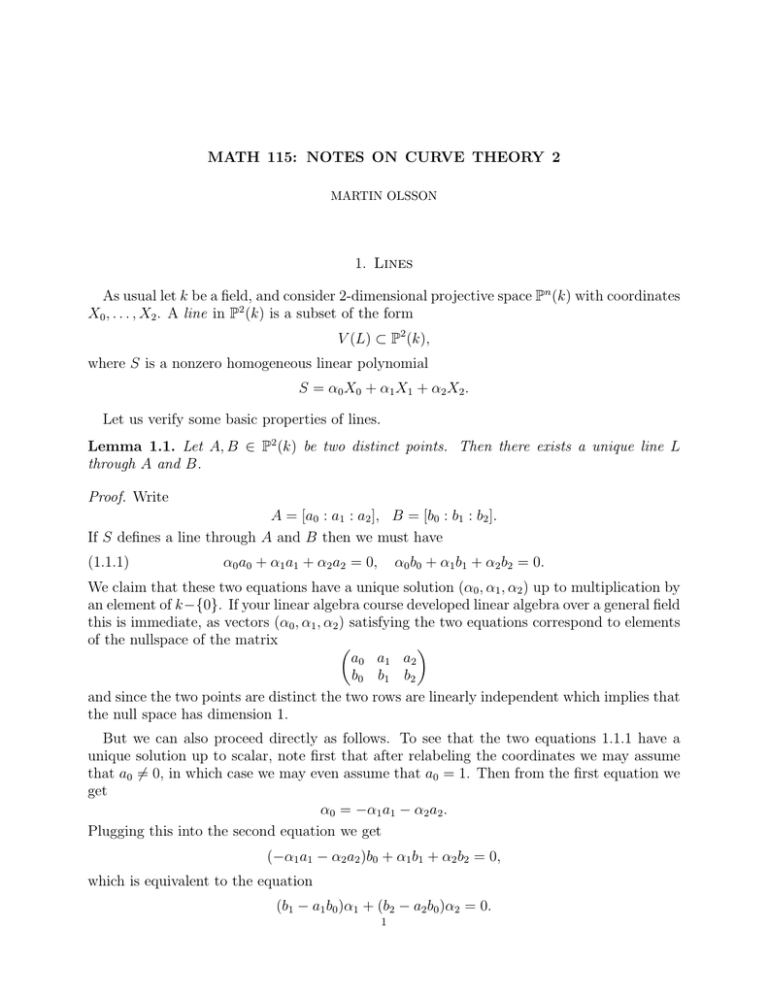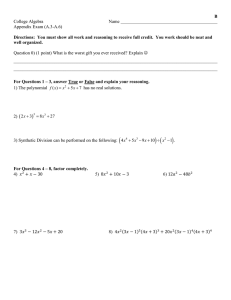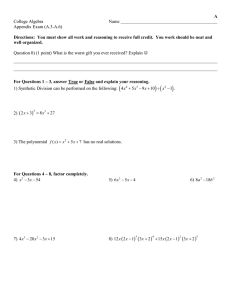MATH 115: NOTES ON CURVE THEORY 2 1. Lines As usual let k
advertisement

MATH 115: NOTES ON CURVE THEORY 2
MARTIN OLSSON
1. Lines
As usual let k be a field, and consider 2-dimensional projective space Pn (k) with coordinates
X0 , . . . , X2 . A line in P2 (k) is a subset of the form
V (L) ⊂ P2 (k),
where S is a nonzero homogeneous linear polynomial
S = α0 X0 + α1 X1 + α2 X2 .
Let us verify some basic properties of lines.
Lemma 1.1. Let A, B ∈ P2 (k) be two distinct points. Then there exists a unique line L
through A and B.
Proof. Write
A = [a0 : a1 : a2 ], B = [b0 : b1 : b2 ].
If S defines a line through A and B then we must have
(1.1.1)
α0 a0 + α1 a1 + α2 a2 = 0,
α0 b0 + α1 b1 + α2 b2 = 0.
We claim that these two equations have a unique solution (α0 , α1 , α2 ) up to multiplication by
an element of k−{0}. If your linear algebra course developed linear algebra over a general field
this is immediate, as vectors (α0 , α1 , α2 ) satisfying the two equations correspond to elements
of the nullspace of the matrix
a0 a1 a2
b0 b1 b2
and since the two points are distinct the two rows are linearly independent which implies that
the null space has dimension 1.
But we can also proceed directly as follows. To see that the two equations 1.1.1 have a
unique solution up to scalar, note first that after relabeling the coordinates we may assume
that a0 6= 0, in which case we may even assume that a0 = 1. Then from the first equation we
get
α0 = −α1 a1 − α2 a2 .
Plugging this into the second equation we get
(−α1 a1 − α2 a2 )b0 + α1 b1 + α2 b2 = 0,
which is equivalent to the equation
(b1 − a1 b0 )α1 + (b2 − a2 b0 )α2 = 0.
1
2
MARTIN OLSSON
Since the two points are distinct, the left side of this equation is not identically zero, and
therefore there exists a unique solution (α1 , α2 ) up to scalar.
2. Tangent lines
Now consider a homogeneous polynomial F in variables X0 , X1 , X2 defining
V := V (F ) ⊂ P2 (k).
For a point P = [a0 : a1 : a2 ], define the tangent line to V at P to be the line defined by the
equation
∂F
∂F
∂F
(a0 , a1 , a2 )X0 +
(a0 , a1 , a2 )X1 +
(a0 , a1 , a2 )X2 = 0.
∂X0
∂X1
∂X1
Note that this is not always well-defined as all the partial derivatives might be zero. Let
TP V denote this tangent line. Note that it is independent of the choice of the representative
[a0 : a1 : a2 ] for P .
Lemma 2.1. Let F be a homogeneous polynomial of degree r in variables X0 , . . . , Xn . Then
n
X
∂F
· Xi = rF.
∂X
i
i=0
Proof. Both sides of the stated equality commute with taking linear combinations of polynomials, so it suffices to consider the case when
F = X0i0 · · · Xnin ,
with i0 + · · · + in = r. In this case we have
∂F
· Xs = is X0i0 · · · Xnin .
∂Xs
Summing over all indices s we therefore get
n
n
X
X
∂F
· Xs = (
is )F = rF.
∂Xs
s=0
s=0
Corollary 2.2. The tangent line TP V passes through P .
Proof. We have
2
X
∂F
(a0 , a1 , a2 )ai = (degF )F (a0 , a1 , a2 ) = 0.
∂Xi
i=0
Definition 2.3. A point P = [a0 : a1 : a2 ] ∈ V is called nonsingular if at least one of the
numbers
∂F
∂F
∂F
(a0 , a1 , a2 ),
(a0 , a1 , a2 ),
(a0 , a1 , a2 )
∂X0
∂X1
∂X2
is nonzero.
MATH 115: NOTES ON CURVE THEORY 2
3
Example 2.4. Consider V ⊂ P2 (k) defined by the equation
F = X 2 − dY 2 − Z 2 .
The the partial derivatives are
∂F
∂F
∂F
= 2X,
= −2dY,
= −2Z.
∂X
∂Y
∂Z
If 2d is not zero in the field k, then the only simultaneous solutions of these equations are
given by the point (0, 0, 0) which does not define a point of projective space, so in this case V
is nonsingular at every point. If 2 = 0 in the field, however, then all these partial derivatives
are zero, and so there are no nonsingular points. Finally if 2 6= 0 in k, but d = 0 in k, then
the only simultaneous solution of the equations of the partial derivatives is given by [0 : 1 : 0],
which is also a solution of F , so in this case all points except [0 : 1 : 0] are nonsingular.
Example 2.5. Consider V ⊂ P2 (k) defined by the equation
F = Y 2 Z − X 3 + AXZ 2 + BZ 3 ,
and assume that 6 6= 0 in k. The condition that V is nonsingular at every point can then be
ensured by the condition that the disciminant
∆ := 16(4A3 − 27B 2 )
is nonzero. This can be seen as follows. First we compute the partial derivatives
∂F
∂F
∂F
= −3X 2 + AZ 2 ,
= 2Y Z,
= Y 2 + 2AXZ + 3BZ 2 .
∂X
∂Y
∂Z
Let P = [x, y, z] be a point of V which is singular. Then from the vanishing of
that either y or z is zero. We consider each of these cases separately.
∂F
∂Y
we get
For the case z = 0, note that then we have (since P is a point of V )
−x3 = 0,
which implies that x = 0. We are therefore looking at the point [0 : 1 : 0]. But for this point
(0, 1, 0) 6= 0 so this case provides no singular points.
we have ∂F
∂Z
In the case when y = 0, we may assume that P = [x : 0 : 1], where x is a simultaneous
solution of the equations
X 3 − AX − B = 0, −3X 2 + A = 0, 2AX + 3B = 0.
Now if these equations are satisfied, then we get that
−3B = 2AX
which upon squaring gives
9B 2 = 4A2 X 2 .
Also from the second equation we get
A = 3X 2 ,
so we get that
27B 2 = 4A3 ,
which contradicts our assumption that ∆ 6= 0.
4
MARTIN OLSSON
Exercise 4. Let k be a field and let L1 and L2 be two distinct lines in P2 (k). What are the
possibilities for the number of points in the intersection L1 ∩ L2 ?
Exercise 5. The Euclidian algorithm for polynomials works over any field. In this exercise
verify this and some of the basic consequences as follows. Throughout k is a field.
(a) Show that if f and g are polynomials, then there exist unique polynomials h and r with
deg(r) < deg(g) such that
f = gh + r.
(b) Show that if a ∈ k is an element and f is a polynomial with f (a) = 0, then
f = (x − a)g
for some polynomial g.
(c) Let f be a polynomial of degree d, and suppose f has d − 1 roots a1 , . . . , ad−1 in k.
Show that then in fact f has d roots in k and f factors into a product of linear factors.
(d) Let f be a polynomial of degree d. Show that f has at most d roots in k.
Exercise 6. Let s be a complex variable (but if you have not taken any complex analysis
you can just assume s is a real variable), and let
∞
X
ζ(s) :=
n−s .
n=1
(a) Show that ζ(s) converges for s whose real part Re(s) is > 1.
(b) Makes sense of the infinite product (taken over all primes p)
Y
(1 − (1/p)s )−1 ,
p
and show in particular that this infinite product converges for Re(s) > 1.
(c) Show that for Re(s) > 1 we have
ζ(s) =
Y
(1 − (1/p)s )−1 .
p


